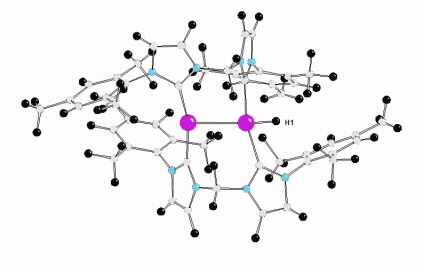Materials which are required to allow a chemical reaction to proceed at a useful rate, but are left unchanged by the overall chemical reaction, are called catalysts. The use of catalysts to facilitate the reactivity of processes which are otherwise energetically unfavourable is a major area of chemistry research.
Catalysis finds applications in both the industrial setting, and in widely distributed consumer devices. For example, considerable effort is directed at finding a catalyst which would facilitate the oxidation of highly abundant gaseous methane into the more easily handled and transported liquid methanol.
Catalytic converters which facilitate pollutant reduction are now present in most cars, and the search for a catalyst that can safely be used to generate hydrogen and oxygen from water for combustion in consumer fuel cell devices is the current holy grail of chemical catalysis.
 |
| Neutron diffraction patterns for a crystal of the dipalladium as a PF6 salt at 150 K (top) and 100 K (bottom). The crystal orientation is unchanged and a phase change, which may shed further light on potential catalytic behaviour, is evident by the change of the diffraction pattern. |
Catalysis
The systematic pursuit of chemical compounds that can facilitate the lowering of the energetic pathway of particular chemical reactions relies on an ability to fully characterise the compounds targeted either as potential catalysts or as suitable model systems from which the operation of catalytic systems may be better understood. In this regard it is imperative that the structure of the compounds be fully understood in terms of their atomic composition, connectivity and bonding.
Why use neutrons for finding hydrogen?
Since the work of Bragg gave rise to the means for determining the structure of complex crystalline materials at the atomic level, the application of crystallographic methods to characterise potential catalysts has become an integral part of catalysis studies.
X-ray diffraction studies find large-scale application to this problem, but are inherently less sensitive to the positions of hydrogen atoms than the heavier elements. This is due to the physical process in which the X-rays are scattered by the electrons of the crystal.
Hydrogen atoms present in a compound may have no electrons at all, when in the formal +1 oxidation state. Electrons which are formally considered to “belong” to the hydrogen – one if neutral and two if carrying a negative charge – although present near the atomic nucleus, will typically be distorted away from the hydrogen atom’s nuclear position by chemical bond formation leading to a comparable distortion of any model built from X-ray diffraction data.
Neutron diffraction, by contrast, is effected by the interaction of the neutron beam with the nuclear density of a crystal (not the electron density). The interaction of neutrons with the H nucleus is especially strong, and the position of hydrogen nuclei is thereby well determined.
Structure of the catalyst under investigation
Materials of potential catalytic relevance are the subject of ongoing investigations by Michael Gardiner at the University of Tasmania. His work aims to improve the fundamental understanding of the way catalysts work especially at the level of how the electrons are distributed about the true atomic positions, how they form bonds to reactant molecules in the catalytic process and how this can give a catalytic effect.
 |
| Fig 1. A novel dipalladium molecular cation of potential catalytic relevance [Formula: C50 H57 N8 Pd2 . PF6 . 4(C4H8O) (Cation : Anion : Solvent = 1 : 1 : 4)]. All hydrogen atoms (black) are observed. The hydridic hydrogen H1 is bonded to one of the two palladium atoms (pink); carbon atoms are shown in grey and nitrogen in blue. The molecule as depicted is monocationic - i.e. carries a charge of +1 and crystallises with a PF6- anion as a tetrahydrofuran solvate. |
Whilst the presence of an hydridic (H–) hydrogen was suspected in the novel binuclear palladium molecular cation shown in Fig. 1 [1], neither the spectroscopic observations nor the theoretical modelling provided sufficient evidence for the development of a complete and accurate structural model of the material incorporating this species.
Neutron-diffraction studies using ANSTO’s Laue Diffractometer, Koala have proved that a hydride (H1) is indeed present in crystals of the material and further, that it is located in a terminal position at one end of a palladium-palladium bond (see Fig. 1) rather than in a bridging configuration as suggested by an earlier computer modelling study.
This means that in the crystal the two ends of the molecule are clearly different from each other and have two different metal atom sites with which reactants could interact, rather than having a pair of chemically equivalent metal atoms.
The diffraction patterns we obtain from our single-crystal neutron-diffraction experiments on Koala are shown in Fig. 2: at 150 K (at top) from which this structure has been determined and at bottom, the analogous experiment at 100 K yields a clearly related pattern in which most of the spots on the upper image are split into two nearly equal components.
Cycling between the two temperatures switches reversibly between the two distinct patterns. The characterisation of this fully reversible phase change demonstrated in Fig. 2 for this material will be the subject of further neutron-diffraction studies and neutron spectroscopy.
Authors
Alison J. Edwards1, Michael G. Gardiner2
1ANSTO, 2School of Chemistry, University of Tasmania
Reference
- Boyd, P. D. W., Edwards, A. J., Gardiner, M. G., Ho, C. C., Lemée-Cailleau, M-H., McGuinness, D. S., et al. (2010). Reduction of a chelating bis(NHC) palladium(II) complex to [{μ-bis(NHC)}2Pd2H]+: a terminal hydride in a binuclear palladium(I) species formed under catalytically relevant conditions. Angewandte Chemie International Edition, 49(36), 6315-6318).
Published: 25/03/2011


